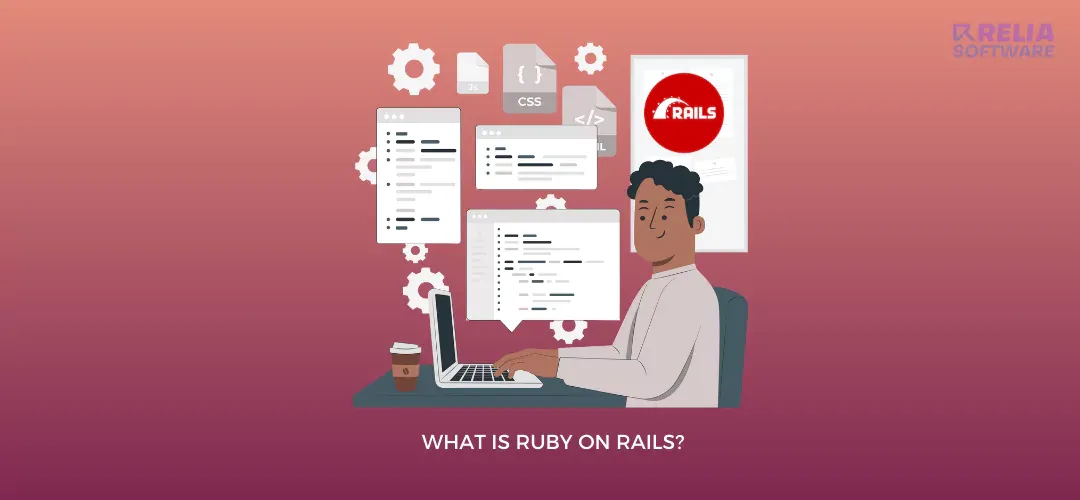Table of Contents
Amongst the diverse web frameworks available, Ruby on Rails (often simply referred to as Rails) stands out as a powerful and versatile option. It's a full-stack framework, meaning it encompasses the entire web development process, from the back-end server-side logic to the front-end user interface. This comprehensive approach empowers developers to build robust and scalable web applications with remarkable efficiency.
Now that we've established the significance of web frameworks and introduced Ruby on Rails, let's dive deeper and explore its defining characteristics, key features, and the advantages it offers developers in crafting exceptional web experiences.
>> Read more: What is Full-Stack Development?
What is Ruby On Rails?
Ruby on Rails (known as Rails) is a full-stack web application framework written in the Ruby programming language. It streamlines the development process by providing a structured foundation and pre-built components for both the server-side (back-end) and client-side (front-end) of a web application.
Originally created by David Heinemeier Hansson in 2004, Rails gained popularity for its focus on developer productivity and its "convention over configuration" approach, which reduces the need for repetitive coding.

Core Features of Ruby on Rails
Ruby on Rails boasts a collection of features that contribute to its efficiency and developer-friendly nature. Here's a breakdown of some key features:
Convention over Configuration (CoC)
This core principle encourages consistent coding practices and reduces the need for excessive configuration. Rails enforces pre-defined conventions for tasks like naming files and structuring code, saving developers time and effort.
Model-View-Controller (MVC) Architecture
Rails adheres to the MVC architecture, which separates an application into three distinct layers:
-
Model: Represents the data and business logic of the application.
-
View: Handles the presentation layer, defining how data is displayed to the user.
-
Controller: Acts as the intermediary between the Model and View, handling user requests and manipulating data as needed. This separation of concerns promotes clean code, easier maintenance, and better testability.
Built-in Libraries (Gems)
Rails comes bundled with a vast ecosystem of pre-written code modules called "gems". These gems provide functionalities for various tasks like authentication, database interaction, image processing, and more. This extensive library collection eliminates the need to reinvent the wheel and empowers developers to integrate desired features quickly.
Active Record
This powerful component acts as an Object-Relational Mapper (ORM). It bridges the gap between Ruby objects and relational databases, allowing developers to interact with databases using intuitive Ruby syntax. Active Record simplifies data access, manipulation, and migration, streamlining database interactions.
Automatic Testing
Rails encourages a test-driven development (TDD) approach by providing built-in tools for writing unit and integration tests. These automated tests ensure code quality, catch errors early on, and facilitate future code changes with confidence.
>> Read more: What is Automation Testing in Software Development?
Scaffolding
This handy feature allows developers to quickly generate the basic structure of a web application, including models, views, and controllers, for common functionalities like CRUD (Create, Read, Update, Delete) operations. Scaffolding accelerates the development process, especially for simple applications or creating prototypes.
Security Features
Rails prioritizes application security by offering built-in mechanisms for preventing common web vulnerabilities like SQL injection and Cross-Site Scripting (XSS). These features help developers build secure applications without needing to implement security measures from scratch.
Remember, this is not an exhaustive list, but it highlights some of the core features that contribute to Ruby on Rails' popularity and efficiency in web development.
Benefits of Using Ruby on Rails
Ruby on Rails offers a multitude of advantages for developers and businesses alike. Here are some key benefits that make it a compelling choice for building web applications:
Increased Development Speed
-
Convention over Configuration (CoC): Reduces boilerplate code and simplifies development, leading to faster coding and project completion.
-
Built-in Libraries (Gems): A vast collection of pre-written and tested code modules readily available for various functionalities, eliminating the need to build everything from scratch.
-
Scaffolding: Generates the basic structure for common tasks, accelerating development, especially for simple applications or prototypes.
Improved Code Readability and Maintainability
-
MVC Architecture: Promotes clean code separation (Model, View, Controller), making the code base easier to understand, maintain, and modify.
-
Convention over Configuration: Consistent coding practices lead to predictable code structure, simplifying collaboration and future maintenance.
Large and Active Community
-
Extensive online resources, tutorials, and forums provide access to support, best practices, and solutions from a large and active developer community.
-
Wide range of readily available plugins and tools developed by the community further enhance functionality and extend Rails' capabilities.
Cost-Effectiveness
-
Open-source framework: Freely available to use and modify, eliminating licensing costs.
-
Reduced development time: Faster development process translates to lower development costs compared to custom-built solutions.
-
Active community: Access to free community resources and support minimizes reliance on paid external services.
Scalability
-
Robust architecture: Rails applications can be efficiently scaled to handle increasing user traffic and data volume.
-
Horizontal scaling: Allows adding more servers to distribute workload and improve performance as needed.
Focus on Business Logic
-
By handling repetitive tasks and providing pre-built functionalities, Rails allows developers to focus on the unique business logic and core features of their application, leading to faster innovation and time-to-market.
While these are not the only advantages, they highlight the significant benefits that Ruby on Rails offers for developing web applications efficiently, cost-effectively, and maintainably.

Use Cases of Ruby on Rails
While Ruby on Rails can be used for a wide range of web applications, here are some specific use cases where it shines:
-
Rapid Prototyping: Rails' "convention over configuration" and pre-built components like scaffolding allow developers to quickly build basic prototypes and test their feasibility before significant time and resources are invested.
-
Minimum Viable Products (MVPs): The speed and efficiency of development with Rails make it ideal for creating MVPs, allowing businesses to validate their product concepts with real users before committing to further development.
-
Content Management Systems (CMS): Rails provides a solid foundation for building CMS systems due to its ease of use, flexibility, and extensive community support for plugins and extensions.
-
E-commerce Platforms: Features like user management, secure payment processing, and scalability make Rails a popular choice for building e-commerce platforms like Shopify and Basecamp.
-
Social Networking and Online Communities: Rails' ability to handle high user traffic and real-time interactions makes it suitable for building social networking platforms and online communities.
-
SaaS (Software-as-a-Service) Applications: The scalability and robust nature of Rails applications render them well-suited for building SaaS products that require reliable performance and the ability to handle growing user bases.
-
APIs (Application Programming Interfaces): Rails is a popular choice for building APIs due to its clean architecture and focus on code maintainability, making it easier to create well-documented and easy-to-use APIs.
-
Single-Page Applications (SPAs): While not traditionally used for SPAs, Rails can be effectively leveraged alongside frameworks like React or Vue.js to build the back-end functionality and API that powers the SPA's front-end.
-
Internal Tools and Dashboards: Companies often utilize Rails to build internal tools and dashboards that streamline their operations and provide data visualization for decision-making.
-
Real-time Applications: Rails, coupled with libraries like WebSockets, can be used to build real-time applications with features like live chat, collaborative editing, and live streaming functionalities.
It's important to note that these are just some examples, and the versatility of Ruby on Rails allows it to be adapted to various web development needs beyond these specific use cases.
Real-World Examples of Popular Applications Built with Rails
Airbnb (Travel & Hospitality)
This massive online marketplace for vacation rentals and experiences heavily relies on Rails. Rails' features like MVC architecture and scaffolding likely played a role in the rapid development and scaling of the platform. Additionally, the vast ecosystem of Ruby on Rails gems likely provided functionalities for user management, secure transactions, and complex search functionalities.
GitHub (Software Development)
This popular version control platform for software development utilizes Rails for its core functionality. Rails' MVC architecture likely facilitates the clear separation of concerns between code management, user interaction, and data presentation. The focus on developer experience and ease-of-use aligns well with Rails' emphasis on clean code and rapid development.
Shopify (E-commerce)
This leading e-commerce platform empowers entrepreneurs to build and manage online stores. Rails' built-in functionalities like secure payment processing and user management likely contribute to a robust and user-friendly shopping experience. Additionally, the vast community of Ruby on Rails developers likely provides access to plugins and extensions that enhance Shopify's functionality for a wide range of online stores.
Hulu (Streaming Services)
This popular streaming platform leverages Rails for various aspects of its service. Rails' ability to handle high user traffic and data volume is likely crucial for smooth video streaming and user interaction. The framework's robust architecture and scalability may allow Hulu to seamlessly expand its content library and user base.
Twitch (Live Streaming)
This interactive platform for live streaming video games and entertainment is built with Ruby on Rails. Rails' ability to handle real-time communication and high-bandwidth data likely contributes to the platform's smooth live streaming functionality. Additionally, Rails' focus on rapid development may have played a role in the quick evolution of Twitch's features and user interface.
These are just a few examples, and the diverse applications highlight the versatility and adaptability of Ruby on Rails across various industries.
Comparison of Rails with Other Frameworks
Comparing Ruby on Rails with other popular web development frameworks involves looking at several key aspects such as language, architecture, performance, ecosystem, and community support. Here's a brief comparison of Rails with Django (Python), Laravel (PHP), and Express.js (Node.js).
Language
-
Rails: Written in Ruby, known for its elegance and readability. Ruby's syntax is clean and expressive, making it a favorite among developers who prioritize developer happiness and productivity.
-
Django: Uses Python, which is renowned for its simplicity and versatility. Python's wide range of applications, from web development to data analysis, makes Django a strong choice for projects that may integrate with other Python-based systems.
-
Laravel: Built with PHP, a language widely used for web development. PHP's extensive use in the web domain, especially in shared hosting environments, makes Laravel a practical choice for many developers.
-
Express.js: Based on Node.js, allowing developers to write server-side code in JavaScript. This is particularly appealing for teams that work with JavaScript on the frontend, enabling a full-stack JavaScript environment.
Architecture
-
Rails: Follows the MVC (Model-View-Controller) architecture, promoting a well-organized codebase and separation of concerns.
-
Django: Also adheres to the MVC pattern, though it's often referred to as MVT (Model-View-Template) in the Django context. This framework is designed for rapid development and clean, pragmatic design.
-
Laravel: Implements MVC architecture, offering a rich set of functionalities such as routing, sessions, and caching, making it highly expressive and comprehensive.
-
Express.js: Minimalist and unopinionated, Express provides the bare minimum to build web applications, giving developers the freedom to structure their applications as they see fit.
Performance
-
Rails: While not the fastest framework due to Ruby's execution speed, Rails' performance is sufficient for most web applications, and it can be optimized for higher scalability.
-
Django: Python's performance is similar to Ruby's, but Django's optimized for rapid development rather than execution speed. However, it scales well for most applications.
-
Laravel: PHP has improved significantly in performance, especially with the PHP 7.x versions. Laravel applications can perform well with proper optimization and server configuration.
-
Express.js: Benefits from Node.js's non-blocking I/O model, which can lead to better performance for I/O-bound applications. It's highly scalable and efficient in handling concurrent requests.
Ecosystem and Community
-
Rails: Boasts a rich ecosystem with a wide array of gems (libraries) for various functionalities. The community is vibrant and supportive, with extensive documentation and resources.
-
Django: Has a strong ecosystem, especially for data-driven applications. The Python community is large and active, providing numerous packages and tools that integrate well with Django.
-
Laravel: Features a robust ecosystem with many packages for extending its capabilities. The Laravel community is known for its enthusiasm and the availability of learning resources.
-
Express.js: Benefits from the vast npm ecosystem, offering a multitude of packages for nearly any functionality. The Node.js and Express community is large and active, contributing to a wealth of resources and support.
Learning Curve
-
Rails: Might have a steeper initial learning curve for beginners unfamiliar with Ruby or the MVC architecture.
-
Django: Easier to learn for those familiar with Python, but still requires understanding its structure and functionalities.
-
Laravel: Relatively easier learning curve for developers with prior PHP experience.
-
Express.js: Steeper learning curve compared to full-stack frameworks, requiring knowledge of JavaScript and Node.js fundamentals.
Ideal Use Cases
-
Rails: Excels in rapid prototyping, MVP development, and building user-centric applications like e-commerce platforms and content management systems.
-
Django: Well-suited for data-driven web applications, complex back-end logic, and scientific computing projects alongside web development.
-
Laravel: Well-suited for enterprise applications, complex web applications, and projects requiring high performance.
-
Express.js: Well-suited for building APIs, microservices, real-time applications, and single-page applications (SPAs) when combined with front-end frameworks like React or Vue.js.
Overall, each framework has its strengths and is suited to different types of projects. The choice between them often depends on the specific requirements of the project, the development team's familiarity with the underlying language, and the ecosystem that best supports the application's needs.
How to Get Started with Ruby on Rails Development?
Here's a roadmap to guide you on your journey towards becoming a Rails developer:
Step 1: Setting Up Your Development Environment
-
Install Ruby: This is the foundation of Rails. Download and install the latest stable version of Ruby from https://www.ruby-lang.org/en/.
-
Install Ruby on Rails: Use the gem command included with Ruby to install Rails. Open your terminal and run: gem install rails.
-
Set up a Text Editor or IDE: Choose a code editor or Integrated Development Environment (IDE) that you're comfortable with. Popular options include Visual Studio Code, Sublime Text, and RubyMine. Configure it for Ruby and Rails development.
-
Verify the Installation: Create a simple Rails application to confirm everything is set up correctly. Run: rails new my_app (replace my_app with your desired application name). This will generate the basic structure of a Rails application.
>> Read more: Top 10 Ruby on Rails IDEs for Web Development Projects
Step 2: Learning Basic Ruby Programming
-
Grasp the fundamentals: Before diving into Rails, it's crucial to understand the core concepts of Ruby programming. This includes variables, data types, operators, control flow statements, methods, and objects. Several online tutorials and resources can help you learn Ruby effectively.
-
Practice and experiment: Don't just read - engage with the material through exercises and small coding challenges. Online platforms like Codecademy offer interactive Ruby learning pathways.
Step 3: Exploring Rails Tutorials and Resources
-
Official Rails Guides: The official Ruby on Rails Guides (https://guides.rubyonrails.org/) are an excellent starting point. They cover a wide range of topics, from basic concepts to advanced functionalities.
-
Interactive tutorials: Platforms like Try Ruby (https://try.ruby-lang.org/) and Rails Tutorials (https://guides.rubyonrails.org/) offer interactive coding environments where you can learn by doing.
-
Online courses and video tutorials: Numerous online courses and video tutorials can provide structured learning paths and visual explanations of Rails development concepts.
-
Community forums and documentation: The Rails community is active and helpful. Engage in forums like Stack Overflow and the official Rails forum (https://guides.rubyonrails.org/) to ask questions and learn from others.
Remember: This is just the beginning. Learning Rails takes dedication and practice. As you progress, consider building small projects to solidify your understanding and explore different functionalities in a practical setting.
FAQs
What are Ruby on Rails alternatives?
Ruby on Rails, while a powerful and popular framework, isn't the only option for web development. Here are some notable alternatives:
-
Full-Stack Frameworks: Django (Python); Laravel (PHP); ASP.NET MVC (C#); etc.
-
Minimal Frameworks and Libraries: Express.js (Node.js); Flask (Python); etc.
Selecting the best alternative depends on various factors: Project requirements. Team expertise, Learning curve, Community and resources, etc. Remember, there's no "one size fits all" solution. Carefully evaluate your project, team, and priorities to make an informed decision about the best alternative for your web development needs.
Is Ruby a dead language?
No, Ruby is not dead. Here are some reasons why:
-
Active Development: Ruby continues to receive regular updates and improvements. The latest version, Ruby 3.2, was released in April 2023 with optimizations and new features.
-
Large and Active Community: Ruby has a large and active community of developers who contribute to open-source libraries, frameworks like Rails, and support platforms.
-
Wide Range of Applications: Ruby is used in various applications beyond web development, including data science, machine learning, and automation tools.
-
Popularity: While it might not be the most popular language overall, Ruby still ranks 19th in the TIOBE Index as of March 2024, indicating its continued relevance and use.
Rumors of Ruby's death are often based on its decline in popularity compared to other languages like Python or JavaScript. However, it's important to understand that different languages have different strengths and weaknesses, and they are often used for different purposes. While some languages might be experiencing faster growth, it doesn't necessarily mean other languages are becoming obsolete.
Are Ruby and Ruby on Rails the same thing?
Ruby and Rails are closely related but distinct. Ruby is a versatile programming language, while Rails is a web development framework built on Ruby. Think of Ruby as the building blocks and Rails as a pre-built structure using those blocks. You can use Ruby alone for various tasks, but Rails requires Ruby as its foundation for web development. Choosing between them depends on your project goals - general programming or building web applications.
What are Rails disadvantages?
Ruby on Rails, despite its numerous strengths, has some weaknesses that you should consider when choosing a framework for your project:
-
Performance: Compared to some frameworks like Node.js or Go, Rails applications can exhibit slower runtime performance, especially for complex tasks involving high data volume or user traffic. This can be a significant concern for applications requiring high responsiveness and scalability.
-
Steep Learning Curve: While Rails aims for simplicity, its underlying concepts and structure, including the MVC architecture and Ruby syntax, can pose a steeper learning curve for developers unfamiliar with these aspects. This can lead to a longer initial learning period compared to some simpler frameworks.
-
Limited Control: Rails' "convention over configuration" approach can feel restrictive for some developers who prefer more granular control over every aspect of their code. This can limit customization freedom and might not be ideal for highly unique or specialized applications.
What is the future of Rails?
Despite some potential drawbacks, the future of Ruby on Rails remains promising:
-
Active Development: Regular updates and improvements continue, with the recent release of Rails 7 showcasing ongoing evolution.
-
Large Community: A vibrant community provides ongoing support, resources, and learning opportunities for developers.
-
Maturity and Stability: As a mature framework, Rails offers stability and a well-established ecosystem for long-term projects.
-
Adaptability: While primarily focused on web development, Rails can adapt to evolving trends like API development and integration with other technologies.
Therefore, while other frameworks might be gaining prominence, Rails remains a strong contender for building web applications, especially when considering its ease of use, mature ecosystem, and active community.
>> Read more: An In-Depth Guide for Deploying Ruby App to AWS Lambda
Conclusion
Ruby on Rails, while not without weaknesses, remains a powerful and relevant framework for web development. Its ease of use, strong community, and mature ecosystem make it a valuable tool for building various web applications. However, the best choice for your project depends on specific needs, team expertise, and desired features. Carefully weigh the strengths and weaknesses of Rails against other alternatives to make an informed decision that aligns best with your development goals.
>>> Follow and Contact Relia Software for more information!
- Web application Development
- Mobile App Development
- E-commerce
- development
- coding




